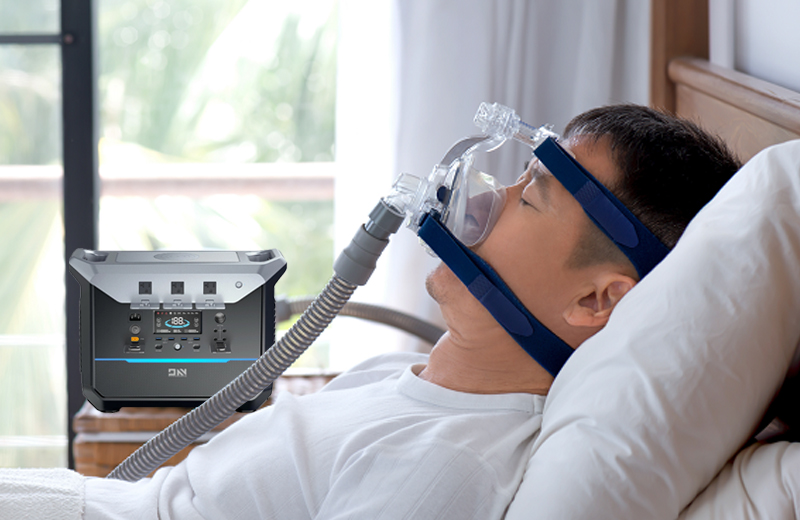
Portable continuous positive airway pressure (CPAP) machines are an essential piece of equipment for people living with sleep apnea. These devices help you stay healthy by giving you steady airflow that keeps your airways open while you sleep. But what happens when your camping trip, long drive, or other extended time away from home prevents access to a wall outlet? How do you keep your CPAP powered up so that you can get the rest you need? It’s not uncommon for overnight sleeping aids to drain batteries quickly. Between all the different devices we use in our bedrooms—phone charging stations, light alarms, and video monitors among them—it’s no surprise that battery life everywhere is at risk. This is especially true if your CPAP uses as much energy as most CPAPs do. Fortunately, there are many ways to keep a CPAP powered up wherever you go.
What is CPAP?
CPAP stands for continuous positive airway pressure. CPAP machines use a gentle stream of air to keep your throat open and prevent you from snoring loudly or even stopping breathing entirely while you sleep. They are an essential part of treatment for sleep apnea, a disorder that causes frequent pauses in breathing throughout the night. If someone in your house has sleep apnea, you may have heard the sound of their CPAP machine through the walls at night. It’s not the quietest equipment, and it can be tough to get used to the sound. Fortunately, many modern CPAP models have replaced the whirring sound of a motorized pump with a smaller and quieter flow of air. Some even have timers you can set to turn off after a certain number of hours to save even more energy.
What are the benefits of using a CPAP machine?
Reduces the risk of heart disease – Sleep apnea has been linked to a 30% increased risk of heart disease. CPAP therapy can reduce your risk by up to 50%. Reduces the risk of diabetes – Those with sleep apnea have an increased risk of developing type 2 diabetes. CPAP treatment can reduce this risk by 50%. Lowers blood pressure – Sleep apnea sufferers have been shown to have higher blood pressure. CPAP therapy can reduce blood pressure in these cases.
CPAP Battery Camping – Tips for Staying Connected While Off the Grid
The first step towards keeping your CPAP machine powered up is to assess how much energy it uses. If your CPAP machine uses a lot of electricity, you may have to look into specific battery types to keep it running. Keep in mind that the higher your CPAP machine draws, the bigger your battery will need to be. While most CPAP machines use between 250 and 400 watts of power, there are some that use much more. If you’re not sure how much your CPAP machine draws, check the user manual. If your CPAP machine uses less than 400 watts, you can probably use a standard car battery. Alternatively, a deep cycle marine battery (DC-DC battery) is an even better option for powering your CPAP. If your CPAP machine draws more than 400 watts, you’ll need a 24 volt battery. You can find these in solar panels; larger solar panels can often be connected to 24 volts. You can also find 24 volt batteries in electric cars.
Invest in a quality CPAP battery
If your CPAP machine draws more than 400 watts, you may need to invest in a CPAP battery. Many CPAP batteries are designed to function as a backup power supply for CPAP machines. These devices are often small and portable; many come with a handy shoulder strap for easy carrying. The best CPAP batteries are often those that are lithium-based. Lithium batteries typically last longer and can withstand more charge cycles than other types of battery. A typical lithium battery can provide enough power to run a CPAP machine for hours.
Use a solar charger
If you’re camping in an area with access to plenty of sunlight, a solar charger could be the perfect solution. Solar panels are a great way to generate electricity while camping. Some solar panels are designed to charge up batteries. You can plug your CPAP into the same solar panel that you use to charge your phone. This will help keep your CPAP battery charged throughout the day and into the night. Solar panels are an excellent way to keep your CPAP powered up. However, keep in mind that solar panels don’t work in the middle of a cloudy day. If you’re camping in a cloudy area, you may want to look into other charging options. You can always charge up your solar panels during the day and then use them to charge your CPAP battery at night.
How to Charge a CPAP Battery
If you’re lucky enough to have a CPAP battery, you’ll need to charge it before your trip. Most CPAP batteries will have an indicator light letting you know when they’re charged and ready to go. After charging, you can either pack the battery itself or plug your CPAP into the same charging unit. This way, your CPAP machine will stay fully charged while you’re traveling. If you’re using a solar charger, follow the manufacturer’s charging instructions to ensure you’re getting the most out of your solar battery.
Conclusion
Sleep apnea is a serious condition that can have a big impact on your life. Fortunately, many sleep apnea sufferers can benefit from using a CPAP machine. However, it can be challenging to use a CPAP when you’re camping or traveling. If you want to keep your CPAP machine powered up, it’s important to select the right battery type. You can charge your CPAP battery using a solar panel or another charging device. With these tips, you can keep your CPAP machine powered up no matter where your travels take you.
